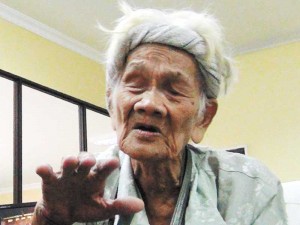In Tulaok, San Simon, Pampanga, Antonina Lalu Garon, known as Lola Garon, lives alone in her small shanty. Blind and in her mid-eighties, she has no one to look after her. Social workers have tried convincing her to live in a shelter for the elderly, but strong-willed Lola Garon insisted on staying in her hut.
Her deep sense of independence springs from her past. Lola Garon is the oldest living female member of the Hukbalahap or Hukbong Bayan Laban sa Hapon a guerrilla movement formed during World War II to fight the Japanese.
Despite her blindness, Lola Garon would still go around her community and travel to Manila. The frail but feisty woman would do anything to protect her scant property, even if it means standing in the face of danger.
Lola Garon was 13 years old when Hukbalahap leader Luis Taruc recruited her to the movement in 1942. Her aversion to the abuse of women encouraged her to fight the Japanese soldiers. She was also among those who looked for food for her comrades.
Lola Garon was assigned to the Huk’s Medical Corps Section (Group II-1), Provision Division, RC-7 (as per Taruc’s certification dated January 11, 2000). Along with other Huks, she went to different provinces in Luzon to evade the enemy. They endured hunger, thirst, fatigue, the scorching heat of the sun, cold nights, and drenching rains.
She and her fellow guerillas endured all these because they believed they had a noble goal—to defend the country from the Japanese invaders.
Lola Garon recounted that there was a time when they did not eat for a week, and when they had to drink from the hollows of carabao trails if it rained.
They survived through the kindness of barrio people who would give them rice wrapped in banana leaves. “We sacrificed. We didn’t want to give our country to foreign colonizers,” she said. “Natutuwa ako dahil ang dinala namin dito [ay] kaunlaran, pagmamahalan, at pagkakaisa ng mga tao. ‘Pag mayroong pagmamahalan, walang gulo. ‘Pag walang gulo, busog ang tao. Makakapagtrabaho nang malaya ang mga tao.”
According to Lola Garon, they knew one another in the Huk organization only by their faces and aliases – never by their real names. She was known as “Tandang Sora”, an alias given by the organization’s political director, Squadron Docebe Jr. Taruc, however, was known as the “Supremo”.
The Huks disbanded after Taruc surrendered in 1954.
Lola Garon is among the diminishing population of World War II veterans. She survives mainly on a P5,000 monthly pension from the Philippine Veterans Affairs Office (PVAO).
Wearing shabby clothes and clutching a tattered bag, Lola Garon showed up at the PVAO to claim her pension for the month of June. This has been going on for years, according to the employees, because her pension was suspended in the late 1990s due to a case of name and alias duplication. Fortunately, a list of veterans from Washington D.C. clarified the mix-up and Lola Garon’s pension was resumed.
Since then, she would drop by the PVAO office to collect her pension, or to borrow money from the employees.
Lola Garon would take the bus from Pampanga to Monumento in Caloocan City, then a cab from Monumento to the PVAO in Camp General Emilio Aguinaldo. Stooped, and clutching a cane for support, she appeared weak and defenseless. But anyone who dares to touch her would be surprised by her strong grip.
But in spite of her physical and financial limitations, Lola Garon has not lost her positive outlook in life. Asked why she has to travel alone, she answered: “Kaya ko, anak. (I can handle it, child).”


